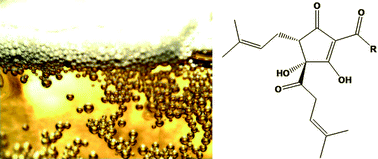Bioavailability of hop-derived iso-α-acids and reduced derivatives
Abstract
Iso-α-acids (

* Corresponding authors
a
UGent-Ghent University, Faculty of Pharmaceutical Sciences, Laboratory of Pharmacognosy and Phytochemistry, Harelbekestraat 72, Ghent, Belgium
E-mail:
Arne.Heyerick@UGent.be
Fax: +32 (0)9 264 8192
Tel: +32 (0)9 264 8058
b UGent-Ghent University, Faculty of Pharmaceutical Sciences, Laboratory of Pharmaceutical Technology, Harelbekestraat 72, Ghent, Belgium
c UGent-Ghent University, Faculty of Pharmaceutical Sciences, Laboratory of Medicinal Biochemistry and Clinical Analysis, Harelbekestraat 72, Ghent, Belgium
d Ghent University Hospital, Faculty of Medicine and Health Sciences, Laboratory of Experimental Cancer Research, De Pintelaan 185, Ghent, Belgium
e UGent-Ghent University, Faculty of Pharmaceutical Sciences, Laboratory of Pharmaceutical Biotechnology, Harelbekestraat 72, Ghent, Belgium
Iso-α-acids (

 Please wait while we load your content...
Something went wrong. Try again?
Please wait while we load your content...
Something went wrong. Try again?
K. Cattoor, J. Remon, K. Boussery, J. Van Bocxlaer, M. Bracke, D. De Keukeleire, D. Deforce and A. Heyerick, Food Funct., 2011, 2, 412 DOI: 10.1039/C1FO10009B
To request permission to reproduce material from this article, please go to the Copyright Clearance Center request page.
If you are an author contributing to an RSC publication, you do not need to request permission provided correct acknowledgement is given.
If you are the author of this article, you do not need to request permission to reproduce figures and diagrams provided correct acknowledgement is given. If you want to reproduce the whole article in a third-party publication (excluding your thesis/dissertation for which permission is not required) please go to the Copyright Clearance Center request page.
Read more about how to correctly acknowledge RSC content.
 Fetching data from CrossRef.
Fetching data from CrossRef.
This may take some time to load.
Loading related content
